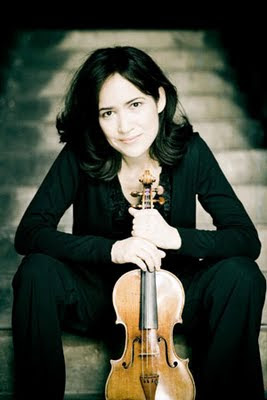 German violinist Viviane Hagner gave a beautiful recital on Tuesday night, sponsored by Washington Performing Arts Society, before a relatively sparse Thanksgiving week audience in the Kennedy Center Terrace Theater. Although Ionarts has reviewed Hagner once before, at Lorin Maazel's Châteauville Foundation in 2007, we missed her 2004 recital with the Foundation for Advanced Education in Sciences. On one hand Hagner is yet another remarkable young female violinist to come out of Munich, but on the other it is difficult to mistake her for Julia Fischer, Arabella Steinbacher, and Lisa Batiashvili -- all students of Ana Chumachenko (and there are many others waiting in the wings). At times Hagner's tone, bordering on strident while still elegant and burred with all kinds of individual corners (another type of listener might say imperfections), reminded me most of Anne-Sophie Mutter.
German violinist Viviane Hagner gave a beautiful recital on Tuesday night, sponsored by Washington Performing Arts Society, before a relatively sparse Thanksgiving week audience in the Kennedy Center Terrace Theater. Although Ionarts has reviewed Hagner once before, at Lorin Maazel's Châteauville Foundation in 2007, we missed her 2004 recital with the Foundation for Advanced Education in Sciences. On one hand Hagner is yet another remarkable young female violinist to come out of Munich, but on the other it is difficult to mistake her for Julia Fischer, Arabella Steinbacher, and Lisa Batiashvili -- all students of Ana Chumachenko (and there are many others waiting in the wings). At times Hagner's tone, bordering on strident while still elegant and burred with all kinds of individual corners (another type of listener might say imperfections), reminded me most of Anne-Sophie Mutter.The program, which favored the unusual over the familiar, opened with a pairing of modern works. Béla Bartók's first rhapsody for violin and piano featured forceful, throaty playing, especially on the lower strings of the 1717 Sasserno Stradivarius loaned to Hagner by the Nippon Music Foundation. In the second movement, Hagner attacked the multiple stops with ferocious accuracy, creating a rabid accelerando that led, in a folk-music-like way, to a barbaric climax. That more raucous work was balanced by a new set of pretty miniatures, Four Chants, composed by Marc-Anthony Turnage for Hagner and premiered by her, with pianist Shai Wosner, in Germany in September. Hagner described the inspirations for the four movements as all happy occasions, and the sounds ranged from eerie calm in the first movement to playful jocosity in the second, with the third movement, for violin alone, full of more searing double stops. The fourth movement, Turnage's reaction to reading a bad review of another of his compositions, was a sort of bluesy foxtrot, with percussive, dissonant jabs in the pianist's right hand dedicated to the critic's poisoned pen. On behalf of the critical profession, we accept this loving tribute with a sense of honor.
Robert Battey, Hagner's violin recital marred by shrill tone (Washington Post, November 26) |
The next concert in the WPAS Classical series will feature pianist Angela Hewitt (December 3, 8 pm), playing Bach's Goldberg Variations in the Music Center at Strathmore. Not to be missed.
Female violinists? (Eye roll) My 88year-old father would describe them that way.
ReplyDeleteOh, for a gender-specific language! I could just call her a Geigerin and no hackles would be raised.
ReplyDeleteWhat would not cause your eyes to roll? Woman violinists?